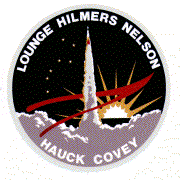 "America's
Return To Space Flight," trumpets the cover of the official
NASA press kit for STS-26, the first Space Shuttle mission since
the Challenger disaster.
"America's
Return To Space Flight," trumpets the cover of the official
NASA press kit for STS-26, the first Space Shuttle mission since
the Challenger disaster. "America's
Return To Space Flight," trumpets the cover of the official
NASA press kit for STS-26, the first Space Shuttle mission since
the Challenger disaster.
"America's
Return To Space Flight," trumpets the cover of the official
NASA press kit for STS-26, the first Space Shuttle mission since
the Challenger disaster.
Almost certainly, most of the news coverage of the event will embrace that theme. The networks will drag out the painfully familiar videotape of Challenger vanishing into a fiery cloud, and offer a slick memorial pastiche to the seven who died.
Post-mortems will recount the findings of the Rogers Commission, and detail the changes made to the Shuttle hardware and to NASA's management team. Someone will wonder aloud about the effects of Challenger's loss on America's children.
Any delays will be treated with more understanding than they were in 1986. But newly emboldened reporters will challenge every available NASA representative and expert, "Is this flight risky?" and "Could it happen again?" Some may even hear truthful answers -- "Yes" to both.
America will be told of the bravery of the five crew members and introduced to their families. We will be treated to an analysis of NASA's budget woes and of opinion polls on the American space program.
All told, STS-26 will receive more media attention than any Shuttle launch since John Young and Bob Crippen rode Columbia into orbit in 1981, and perhaps more even than that maiden voyage. No soap opera, not even Oprah Winfrey, will be safe from pre-emption.
And through it all, the most important question may well be neglected.
Not, "What if it fails?"
But, "What if it succeeds?"
There is both more and less than meets the eye at stake in the flight of STS-26. On paper, it is by no stretch of imagination an ambitious or pioneering mission. It is, rather, a short, conservatively-drawn test flight of the U.S.'s long-mothballed space transporation system. Most of the drama will be fear, and -- if all goes well -- most of the excitement will be relief.
Nor is Discovery's payload, a giant communications satellite, particularly exotic. If successfully deployed, TDRS-C will be an important part of NASA's orbital infrastructure. But it will not by itself stir the imaginations of many ten-year-olds, or raise NASA's stock in Washington.
Perhaps neither the dreams of children nor the opinions of Congressmen are properly the concerns of NASA's astronauts and engineers. But it would be naive to to overlook the impact a successful mission could have on both.
STS-26 is a confidence-builder, not only for NASA itself, but for its political bosses and its public stockholders. National pride, economic vitality, technological leadership -- they may not be on the cargo manifest, but all are part of Discovery's burden.
Mercifully, there is one audience NASA need no longer worry about pleasing. In the post-Challenger reassessment, Reagan freed the space agency from the ugly business of trying to sell the Shuttle to corporate America. Gone is the fiction of the Shuttle as a reliable bargain-priced space truck. Gone is the foolishness of trying to make the Shuttle "cost-effective" (meaning self-supporting).
But NASA still has a major selling job to do. The Space Station project is twisting in the wind, and space science is at a standstill. The agency desperately needs a firmer financial base and a long-term sense of direction. In the current climate, both will be difficult to acquire. A successful return to space by the Shuttle will help, though it will hardly sweep away all skepticism and criticism.
Even so, the greatest danger may not be failure, but complacency. All too easily, America could take a successful Shuttle flight as a welcome sign that all is well again, and relievedly turn its attention elsewhere. The press spotlight would find a new focus, and the hard questions of national space policy and capability would remain unresolved.
And hard questions they are: are we willing to pay the price for a leadership role in space? Should we invest in a space station, a second-generation Shuttle, a heavy-lift launch vehicle? What is our commitment to science and exploration, as compared with commerce and exploitation? Have we struck a proper balance between military and civilian uses of space?
Several study groups, led by such figures as former NASA Administrator Thomas Paine and astronaut Sally Ride, have recently wrestled with these issues. Drawing on those reports, President Reagan's new National Space Policy, quietly announced in February, set "leadership" and an "expand(ed) human presence and activity beyond Earth orbit" as goals.
But Reagan's 1989 NASA budget was battered by Congress, with important science and technology initiatives sacrificed to the cash-hungry Space Station. Moreover, Reagan will leave office in just a few months. With both George Bush and Michael Dukakis silent on space issues (except for SDI), the National Space Policy becomes a shell, and the nation's direction remains an open question.
A successful launch and safe landing of Discovery will not answer that question. STS-26 is about reasserting what we can do today, not deciding what we will do tomorrow. It is no more than a step forward, and a small step at that.
But a step in what direction?
What about Mars?
Once upon a time, there was a Space Race, The United States treated it as a sprint. The Soviet Union treated it as a marathon. In classic tortoise-and-hare fashion, the Soviet Union won.
That conclusion defies conventional wisdom and offends national pride. It's a matter of historic record that America was first to the moon. Neil Armstrong and Edwin Aldrin were America's surrogate warriors, avenging the insult of Sputnik.
But as dramatic as the Apollo 8 flight to the Moon was, memorable as the Apollo 11 landing on the Sea of Tranquility remains, subsequent events have reduced them to symbols.
Whatever lasting scientific, economic, or historical value Apollo might have had was sacrificed by President Nixon, with the collusion of Congress. While hypocritically congratulating "Neil and Buzz" on their achievements, Nixon allowed his budget staff to systematically dismantle NASA's manned program, including cancelling three critical moon landings.
The Nixon White House also killed most of the Apollo Applications Program, which would have made use of the mature technology of the Saturn boosters. Finally, it forced the space agency into a half-a-loaf choice between a budget spaceplane and a cut-down space station. The stage was set for mediocrity.
Meanwhile, the Soviet Union, which disdained the moon, has parleyed inferior technology and superior will and vision to become the world's premiere spacefaring nation.
It did this by setting long-term goals and building to them stepwise, using reliable "workhorse" launch vehicles. They have a viable space station, a powerful heavy-lift booster, and a reusable shuttle ready for its maiden flight. Many observers expect Russian cosmonauts to visit Mars by the end of the century.
Efforts continue in the U.S. to resurrect a new Space Race centered on the Red Planet, fueled by outrage over the Soviet Union's widening lead in space capability. And more than a few supporters of SDI, President Reagan's "Star Wars" defense, view it as a Trojan Horse which will accelerate space development and spur space technology.
Both viewpoints are misguided. Nationalism is tribalism for the modern era, militarism its endemic disease. Neither makes a satisfactory platform for progress -- toward microgravity manufacturing, toward global all-points communications, toward planetary resource management, toward lunar mining and solar power satellites, toward exploration of the planets and beyond.
The first Space Race was a saber-rattling chest-beating battle of egos between two wary Cold Warriors. A race to Mars in the same mode would be a costly rerun of the the race to the Moon -- with the U.S. risking the same sort of pyrrhic victory. Yet, astonishingly, some space advocates have talked out loud about a "sprint" mission to one of Mars' two moons, in the hope of stealing the Soviets' thunder.
Nothing could be worse for the American space program. However much Soviet successes alarm us, America cannot afford to hear the roar of Discovery's engines as a starter's pistol. If there are enough potential rewards to justify a manned mission to Mars, those rewards will still be there to be claimed by the country that comes in second.
Mars can wait.
Time has changed the fundamental equation. No reasonable person asks any longer whether America should be in space. The everyday benefits of the machines placed there and the knowledge won there have become an integral part of our lives. The benefits are rich enough to have drawn the European community, China, Japan, India, and, most recently, Israel into the game.
So we ask not "If..." but "What..." Whether it comes from the top down, in the form of Kennedyesque leadership, or from the bottom up, in the form of grass-roots advocacy, what America needs is a clearly articulated vision of our role in the new Space Age.
Continuing the half-hearted and haphazard efforts of the past will only guarantee continued mediocrity.
In that light, perhaps the best way to view the flight of STS-26 is as our first day back on the job, building the structure of our future in space, with NASA as foreman. We have the best tools, but we keep changing architects and redesigning the plumbing, and sometimes we're not so sure we want to build a home there after all.
Meanwhile, that Russian fellow down the block does things the old-fashioned way, and the home he's building's not fancy. But he keeps working even when it rains or something breaks, and by God, that home he's building is starting to look pretty good.
Where is the architect whose vision will carry the American space program -- commercial, civil, and military -- into the 21st century? And where is the national will to bring that vision to life?
Without both, we risk writing ourselves into the history books as the Portugal of spaceflight. Without both, the flight of STS-26 will be rendered meaningless, a footnote in someone else's story.
There's no reason to think that we can't find both the long-term vision and the will. And we need to find them soon. But for now, it will be enough to get back to work on the goals we do have.
Today Discovery and TDRS-C -- tomorrow Titan 4, the backlog of satellites, the delayed probes to Jupiter and Venus, the Space Telescope and the Space Station. Roll up your sleeves, America. The Shuttle's back.
---September 21, 1988, Goshen, Indiana

Copyright 1988 by Michael P. Kube-McDowell. Originally published in The Elkhart Truth, September 25, 1988. Images courtesy NASA.
Return to Nonfiction bibliography || K-Mac's Home Page.
.